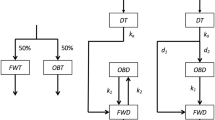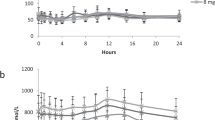Abstract
WE have found that the specific activity of L-amino-acids labelled with tritium, which were isolated after D-amino-acid oxidase treatment of the corresponding generally labelled DL-compound, was much lower than expected. The DL-amino-acids were labelled by exchange with tritiated water in the presence of a platinum catalyst1, and reverse isotope dilution analysis with both D- and L-carriers2 showed that the tritiated amino-acids were labelled in the D- and L-components to the same extent. Paper chromatographic analysis3 confirmed the radio-chemical purity (> 98 per cent) of the DL-amino-acids, which were afterwards treated with crude D-amino-acid oxidase (hog kidney extract) by well-established techniques4. The specific activity of the tritiated compounds was measured by combustion of the compounds in oxygen followed by β-liquid scintillation counting of the tritiated water produced3. The radiochemical purity of the isolated L-amino-acids was determined by paper chromatographic analysis and the optical purity by reverse isotope dilution analysis with both L- and D-carriers. If no labilization of the tritium atoms had occurred, after the D-oxidase treatment the isolated L-isomer should thus have the same specific activity as the parent DL-compound. The results shown in Table 1 illustrate that this is not the case and that there is a substantial loss of tritium from the L-isomer.
This is a preview of subscription content, access via your institution
Access options
Subscribe to this journal
Receive 51 print issues and online access
$199.00 per year
only $3.90 per issue
Buy this article
- Purchase on Springer Link
- Instant access to full article PDF
Prices may be subject to local taxes which are calculated during checkout
Similar content being viewed by others
References
Graul, E. H., and Hundeshagen, H., Atompraxis, 4/5, 154 (1959).
Bayly, R. J., in Radioisotopes in the Physical Sciences and Industry, Pub. I.A.E.A., 305 (Vienna, 1962).
cf. Evans, E. A., and Stanford, F. G., Nature, 197, 551 (1963).
Parikh, J. R., Greenstein, J. P., Winitz, M., and Birnbaum, S. M., J. Amer. Chem. Soc., 80, 593 (1958).
Done, J., and Payne, P. R., Biochem. J., 64, 266 (1956).
Kay, J. G., and Rowland, F. S., J. Org. Chem., 24, 1800 (1959).
Enzymes, by Dixon, M., and Webb, E. C. (Longmans, Green and Co., London, 1958). Chemistry of the Amino Acids, by Greenstein, J. P., and Winitz, M., 2 (J. Wiley and Sons, New York and London, 1961).
Konikova, A. S., Dobbert, N. N., and Braunstein, A. E., Nature, 159, 67 (1947). Braunstein, A. E., Adv. Protein Chem., 3, 2 (1946).
Author information
Authors and Affiliations
Rights and permissions
About this article
Cite this article
EVANS, E., GREEN, R., SPANNER, J. et al. Labilization of the α-Hydrogen Atom of Generally Labelled Tritiated L-α-Amino-acids in the Presence of Renal D-Amino-acid Oxidase. Nature 198, 1301–1302 (1963). https://doi.org/10.1038/1981301b0
Issue Date:
DOI: https://doi.org/10.1038/1981301b0
This article is cited by
-
The metabolism of (?)-ephedrine in man
European Journal of Clinical Pharmacology (1975)
-
Stability of Thymidine Labelled with Tritium or Carbon-14
Nature (1963)
Comments
By submitting a comment you agree to abide by our Terms and Community Guidelines. If you find something abusive or that does not comply with our terms or guidelines please flag it as inappropriate.



